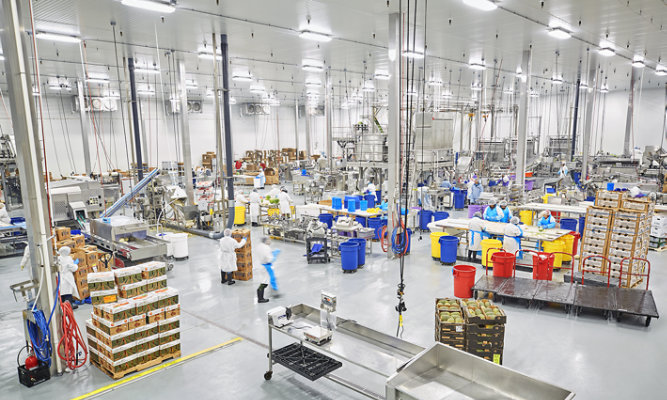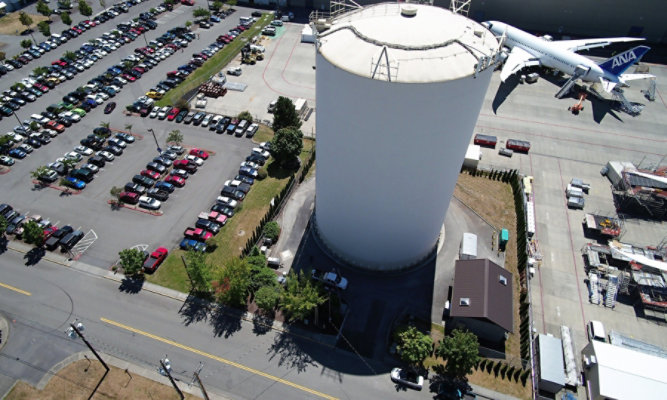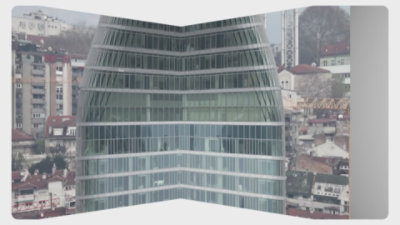From Audit to Action – Partnering with Coatings Specialists for Regulatory Success
Proactive Steps by Plant Managers Can Close Compliance Gaps and Optimize Efficiency Ahead of Regulatory Audits
by Mike Durbin, Market Segment Manager – Pharmaceutical and Data Center Facilities, and Rita Kamoutsis, Regional Segment Director – Manufacturing & Processing, Sherwin-Williams Protective & Marine

In today’s tightly regulated manufacturing world, meeting government standards isn’t just important – it’s vital for keeping products safe and top-quality, and for ensuring workers’ well-being.
That’s where plant audits – whether conducted internally or by third-party auditors – come in. They’re essential for pinpointing any areas where a facility is falling short and needs to make changes before regulatory agencies visit.
For plant managers in the United States, dealing with a complex web of regulations – and undergoing audits by federal agencies like the U.S. Department of Agriculture (USDA), Occupational Safety and Health Administration (OSHA), and U.S. Food and Drug Administration (FDA), and others – can be a persistent challenge.
Conducting an internal inspection can present an opportunity – not just for achieving compliance but also for optimizing operational efficiency and safety protocols. However, internal staff often lack the expertise needed to assess all areas effectively.
Collaborating with a coatings professional for a detailed evaluation can provide valuable insights and recommendations tailored to each facility’s unique needs. Their specialized knowledge of areas requiring protective coatings – such as wet and dry processing areas, mechanical equipment rooms and chemical storage areas – can contribute to longer service lives and reduced maintenance needs, which in turn lowers costs.
By selecting the right coatings and formulations, facilities can mitigate contamination risks, streamline organization and storage, and enhance safety measures like clearly marked evacuation routes. In some cases, these experts can also offer guidance on maintaining thorough documentation, implementing preventive maintenance programs and training staff on compliance protocols to promote regulatory success.
This article will offer practical guidance for proactive preparation and anticipating challenges before audits – helping plants avoid last-minute disruptions and safeguarding their operations.
Ahead of the Audit – Crafting Proactive Repair Specifications
Plant audits are commonplace in many industries and often precede regulatory assessments to identify potential issues beforehand. By proactively addressing findings from these audits, facilities can avoid penalties, product recalls and even plant shutdowns.
During these evaluations, coatings professionals play a crucial role in identifying areas of concern – from addressing peeling paint and rust flakes, to flagging improperly sloped drainage systems, and other aspects of facilities subject to regulatory scrutiny.
Following an evaluation, a facility receives a detailed report with coatings repair specification recommendations. These are tailored to the specific needs of each environment – and should offer long-term solutions rather than quick fixes for compliance. Further training of in-house personnel by the coatings professionals’ team may be suggested. This training will allow the plant employees to identify and to stay on top of minor repairs to keep them from becoming more costly to repair in the future.
Facility evaluation findings help prioritize necessary repairs for the plant manager and may also include quotes for various repair scenarios based on service life, functionality and cost – allowing for informed decisions.
By integrating repair recommendations from coatings professionals into ongoing maintenance programs, facilities can streamline repair timelines, standardize specifications for efficient company-wide implementation, and minimize stress during audits.
A proactive approach not only reduces compliance issues but also paves the way for overall cost savings and uninterrupted operations.

Figure 1: During a facility evaluation, a coatings professional will cover the entire site looking for any potential deficiencies such as corrosion, peeling paint, cracked flooring, and porous surfaces that can harbor bacteria. |

| Figure 2: An auditor may suggest incorporating skid resistance into flooring to reduce the potential for slips and falls and enhance worker safety. |

Figure 3: A coatings professional may recommend that a facility convert longer trench drains into box drains (shown) to reduce the amount of surface area where microbes can become trapped and promote bacteria growth. |
Putting Workplace Safety First – OSHA Assessments
The Occupational Safety and Health Administration (OSHA) sets and enforces workplace safety standards to protect workers from occupational hazards.
Factories are subject to OSHA audits to ensure compliance with safety regulations related to machinery and equipment, hazard communication, personal protective equipment (PPE) and emergency response procedures. A coatings professional can ensure that the coatings used in the workplace comply with such regulations, particularly regarding worker safety, exposure to hazardous materials, ventilation requirements and PPE.
Coatings professionals are trained to recognize potential hazards associated with coating materials, application processes and equipment. During an audit, they can identify any safety hazards related to coatings handling, storage, application or disposal that may pose risks to workers’ health and safety.
A coatings professional can also recommend appropriate control measures to minimize or eliminate hazards identified during the audit.
OSHA audits cover a wide range of areas, including:
- Machine Guarding: Proper guarding of machinery and equipment is essential for preventing injuries such as amputations and crush injuries. Auditors assess the adequacy of machine guarding systems and procedures for ensuring employee safety.
- Hazard Communication: Auditors review hazard communication programs, including labeling, safety data sheets (SDS) and training on chemical hazards.
- Emergency Preparedness: Auditors review emergency response plans, evacuation procedures and employee training on emergency protocols. High-performance coatings can help facilitate clear evacuation routes and rally point identification.
Safeguarding Product Safety and Quality – FDA Inspections
The FDA ensures safety and quality across food, medicine, devices and cosmetics nationwide. FDA inspections thoroughly review quality and safety standards, including temperature monitoring and ventilation control. These annual audits ensure ongoing compliance with industry regulations.
To meet requirements of the Food Safety Modernization Act (FSMA), facilities conduct regular self-audits but may lack expertise. AMPP-Certified Coatings Professionals offer tailored assessments, recommending coatings to enhance durability and minimize maintenance.
Coatings assessments focus on areas where industrial coatings can help ensure compliance with standards of the FDA and the USDA.
Working with sanitation, engineering and maintenance teams, these professionals address issues like rust and drainage and offer valuable insights into minimizing hazards related to slips, falls and burns. They recommend specific skid-resistant surface treatments and seamless resinous flooring systems to mitigate accident risks and prevent bacterial growth. In addition, heat-resistant insulative coatings can protect workers from burns by maintaining cool surface temperatures.
All factories in food, pharmaceutical and medical device manufacturing must undergo FDA audits to comply with Good Manufacturing Practice (GMP) regulations. These audits assess various aspects of the manufacturing processes including:
- Quality Control: Inspectors scrutinize the effectiveness of quality control measures, examine the consistency and precision of manufacturing operations and review how violations are identified and managed.
- Sanitation Practices: Assessments focus on the cleanliness of facilities, equipment and staff, as well as the efficacy of sanitation procedures to prevent contamination. Utilizing appropriate coatings ensures surfaces are easy to clean, sterilizable and resistant to various cleaning methods, boosting sanitation efforts.
- Labeling Compliance: Auditors closely review product labels to verify they accurately represent contents, ingredients, nutritional facts and any mandated warnings or claims.
- Documentation and Record-keeping: Auditors examine batch records, standard operating procedures (SOPs) and other documentation to ensure completeness, accuracy and alignment with regulatory standards.
Safeguarding the Food Supply – USDA Audits
The USDA plays a crucial role in ensuring the safety and quality of meat, poultry and egg products, overseeing inspections of food processing facilities to uphold stringent standards. With sharp attention to detail and solutions, coatings specialists can contribute to maintaining the integrity and compliance of food processing facilities under USDA oversight.
To preserve steel structures in these facilities, coatings specialists may recommend corrosion-resistant coatings that comply with USDA regulations. These coatings not only prevent rust but also facilitate easier cleaning, reducing the risk of contamination from rust or paint chips entering products.
In addition, they could offer advisement on the use of sealers and seamless flooring systems to minimize dust accumulation and deter pest infestation within warehouse areas. Run identification strips are implemented to swiftly identify any presence of rodents, while polyurea coatings safeguard insulated metal panels, preventing flaking and ensuring adherence to sanitation standards.
USDA audits focus on:
- Hazard Analysis and Critical Control Points (HACCP): HACCP plans – which systematically identify and control food safety hazards – are evaluated for effectiveness in preventing, eliminating or minimizing hazards throughout the production process.
- Surface Contamination Prevention: Dirty floors, walls and ceilings can pose contamination risks. Proper coatings play a crucial role in preventing such risks, ensuring surfaces are easy to clean and maintain.
- Sanitation Standard Operating Procedures (SSOPs): Auditors assess the implementation and effectiveness of SSOPs in upholding sanitary conditions and preventing cross-contamination.
- Product Handling and Storage: Auditors review procedures for receiving, storing and handling raw materials and finished products to verify compliance with USDA regulations.
- Efficient Organization and Storage: Adequate line stripping and signage – coupled with suitable coatings – streamline the organization and storage of finished goods.
- Employee Training and Practices: Inspectors evaluate the adequacy of training programs and assess employee practices concerning hygiene, sanitation and food handling.
Sustained Compliance and Long-Term Success
While this guidance can promote facility compliance, inspections often involve unexpected variables.
Regulations change frequently. In this environment, trusted partnerships with coatings professionals prove invaluable. Collaborating with coatings specialists enables facility managers to anticipate and address compliance issues proactively.
Audits can also serve as opportunities for plant managers to bolster operational efficiency, safety standards and regulatory adherence. By adopting an auditor’s mindset – and working with specialists to develop repair strategies – facilities can maintain compliance, avoid fines and prevent operational disruptions.
This proactive approach fosters a culture of continuous improvement and ensures long-term regulatory compliance and operational efficiency.
Discover More
Industry Expertise and Innovation
See how we help customers find customized solutions for their project and application challenges.
Industry Solutions
Explore technology and innovation to protect your most valuable assets.
LEARN MOREProduct Lookup
Find out more about our innovative coatings for a variety of industries.
FIND A PRODUCT

